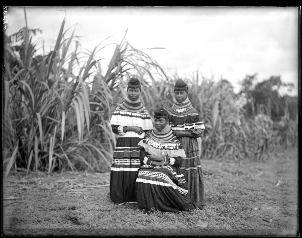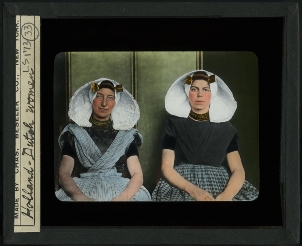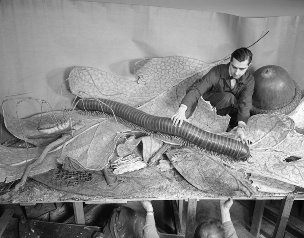American Museum of Natural History Launches Free Online Image Database

Dimock, Julian A. “Three Seminole girls, The Everglades, Florida, 1907.” from the AMNH Digital Special Collections
The American Museum of Natural History’s (AMNH) research library last month hosted the official launch of its new online image database for Digital Special Collections. Begun as a project to digitize 1,000 of the museum’s photos and rare book illustrations using grant funding from the New York Metropolitan Library Council, the Digital Special Collections program has evolved into a long-term project that will offer the public free online access to the museum’s research library collection. The new database includes more than 7,000 archival images that document the Museum’s efforts in New York and around the world, dating back to scientific expeditions from the 19th century.
These images are just a fraction of the museum’s collection, said Tom Baione, AMNH’s Harold Boeschenstein director of library services, during his introduction to the museum’s “Slide Slam: From Archive to Art” event, held last month at AMNH’s Kaufmann Theater to debut the new database. Addressing a full house, Baione reflected on the ways in which the 145-year-old institution’s image collections had served previous generations of educators.
“The Digital Special Collections site, unfortunately, only makes available less than one percent of the images in the library’s collections,” he said. “Before the advent of the Internet and Powerpoint, educators and lecturers had to use slides, and the library sold copies of images from our collections… Every year, we sold tens of thousands of these slides to fill those old-fashioned slide carousels.”

“Dutch women, Ellis Island” [n.d.] (LS173-33) from the AMNH Digital Special Collections
This digitization effort has captured images from many of those lantern slides, “illustrating cultures, paleontology, botany, and zoology in places as diverse as Greenland, Mongolia, and Kenya,” according to an AMNH description.The image database also includes: illustrations from the research library’s collection of 14,000 rare books, “including the work of pioneers in natural science from as early as the 16th century;” the research library’s Julian Dimock Collection of approximately 3,400 photographs on glass “documenting the daily lives of African Americans in South Carolina and Alabama, new immigrants at Ellis Island, and the Seminole Indians of Florida at the turn of the last century;” The Lumholtz Collection, which includes images documenting ethnographer Carl S. Lumholtz’ four expeditions to northwestern Mexico between 1890 and 1898; The Jesup North Pacific Expedition collection documenting “the peoples and cultures of the Pacific Northwest Coast of North America and the eastern coast of Siberia from 1897 to 1902;” and photos capturing the Museum’s own educational programs and activities for New York children throughout the 20th century.
For many of those children, visits to the museum prove to be formative experiences. The “slide slam” event featured two special guests—renowned New York-based artists Mark Dion and Alexis Rockman—who discussed ways in which the museum had inspired their work.

Rota, Alex J. “Installing models for the Forest Floor exhibit, 1958.” (325494) from the AMNH Digital Special Collections
“This institution has been… for me the most important institution in my artistic life,” Rockman said in his opening comments. “My mom used to work here. I took classes in this room when I was a kid,” he said, going on to describe his 1990 painting “Forest Floor” as an homage to a forest floor diorama in the museum’s Hall of North American Forests.
Dion agreed, describing the museum as “an extraordinarily important place for me… I think in the past 30 years I’ve probably visited the museum at least once a month. And nowhere has been more welcoming and warm in the museum than the library. I’ve spent a lot of time in those stacks… And I’m very happy that we’re here to celebrate the images being available in a broader way, so that people can experience the richness that I’ve found in the archive, and continue to find every trip there.”
The Digital Special Collections project utilizes flatbed scanning, adhering to standards and workflows based on the Federal Agencies Digitization Guideline Initiative’s (FADGI) Technical Guidelines for Digitizing Cultural Heritage Materials. Images are cataloged by staff, interns, and volunteers, with data entered into modified Dublin Core fields in an Omeka database.
![Painting, suggested habitat, Canada Lynx and Snowshoe Hare Group, Hall of North American Mammals, [1935] Painting, suggested habitat, Canada Lynx and Snowshoe Hare Group, Hall of North American Mammals, [1935]](http://www.thedigitalshift.com/wp-content/uploads/2014/05/140522_LynxandHare.jpg)
“Painting, suggested habitat, Canada Lynx and Snowshoe Hare Group, Hall of North American Mammals, [1935].” from the AMNH Digital Special Collections
“To maintain historical integrity, we retain legacy information about the images through data fields such as original caption, but include modern terms to ensure discovery through newly generated titles,” the project site explains.Baione emphasized that the site is open to the public, encouraging the audience to visit, browse its collections and special exhibits, and use the images for their own work.
“We encourage folks who are producing lectures or blogging to click, save, and distribute these images,” he said. “Please just let everybody know where they came from…. Now that our new image database is up and running, as we commemorate this, we’re also going to be able to begin to seek funding to get more images…up and out and accessible.”
For additional coverage, see the launch announcement with additional links from Gary Price on LJ infoDOCKET.
RELATED
ALREADY A SUBSCRIBER? LOG IN
We are currently offering this content for free. Sign up now to activate your personal profile, where you can save articles for future viewing









Add Comment :-
Comment Policy:
Comment should not be empty !!!